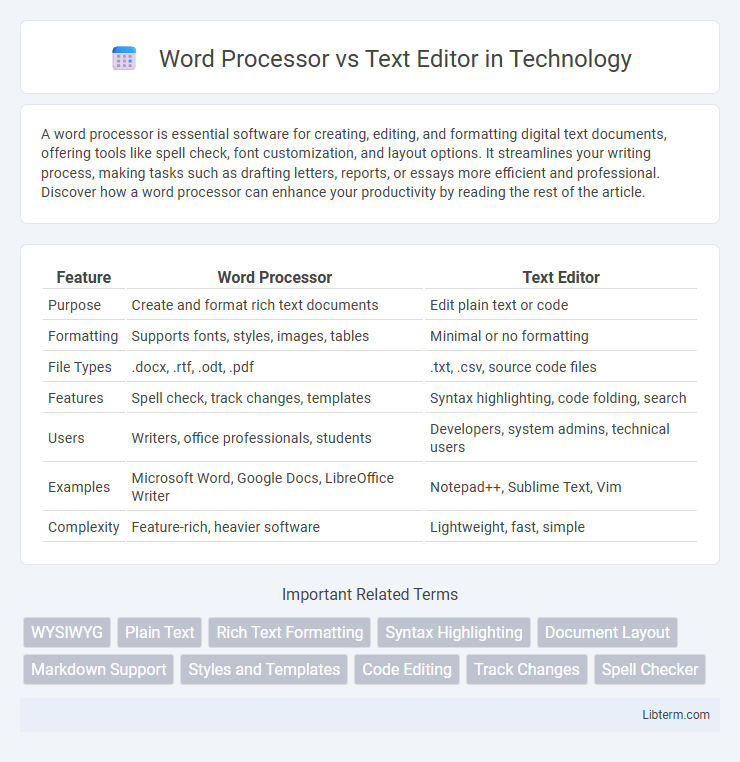A word processor is essential software for creating, editing, and formatting digital text documents, offering tools like spell check, font customization, and layout options. It streamlines your writing process, making tasks such as drafting letters, reports, or essays more efficient and professional. Discover how a word processor can enhance your productivity by reading the rest of the article.
Table of Comparison
| Feature | Word Processor | Text Editor |
|---|---|---|
| Purpose | Create and format rich text documents | Edit plain text or code |
| Formatting | Supports fonts, styles, images, tables | Minimal or no formatting |
| File Types | .docx, .rtf, .odt, .pdf | .txt, .csv, source code files |
| Features | Spell check, track changes, templates | Syntax highlighting, code folding, search |
| Users | Writers, office professionals, students | Developers, system admins, technical users |
| Examples | Microsoft Word, Google Docs, LibreOffice Writer | Notepad++, Sublime Text, Vim |
| Complexity | Feature-rich, heavier software | Lightweight, fast, simple |
Introduction to Word Processors and Text Editors
Word processors are software applications designed for creating, formatting, and editing rich text documents, offering features such as spell check, font customization, and layout options. Text editors provide a lightweight environment primarily for editing plain text or code, focusing on simplicity and fast performance without extensive formatting tools. Understanding their differences helps users choose the appropriate tool for tasks like document creation or programming.
Key Features of Word Processors
Word processors offer advanced formatting options such as font styles, sizes, colors, and paragraph alignment, enabling professional document creation. They include built-in spell check, grammar correction, and thesaurus tools that enhance writing accuracy and quality. Integration with templates, tables, images, and collaborative editing features makes word processors ideal for complex and visually rich documents.
Essential Functions of Text Editors
Text editors primarily focus on essential functions such as plain text creation, syntax highlighting, and basic file manipulation, making them ideal for programming and code editing. They provide minimal formatting options, emphasizing speed, simplicity, and compatibility with various file types, unlike word processors that offer advanced formatting, templates, and multimedia integration. Features like search and replace, line numbering, and customizable macros enhance productivity in text editors by streamlining code writing and editing tasks.
Use Cases: When to Choose Each Tool
Word processors excel in creating formatted documents like reports, resumes, and brochures due to their rich text styling, templates, and layout tools. Text editors are ideal for code editing, quick note-taking, and handling plain text files where minimal formatting is required, offering lightweight performance and syntax highlighting. Choose a word processor for publishing-ready documents and a text editor for programming or simple text manipulation tasks.
User Interface Comparison
Word processors like Microsoft Word and Google Docs feature rich, visually intuitive interfaces with toolbars, ribbons, and formatting palettes designed for easy access to advanced editing, formatting, and collaboration tools. Text editors such as Sublime Text or Notepad++ offer minimalist, lightweight interfaces prioritizing speed, code highlighting, and syntax support tailored for developers and programmers. The user interface of word processors targets general users requiring document design, while text editors focus on efficiency and customization for coding and plain text manipulation.
Formatting Capabilities and Limitations
Word processors offer extensive formatting capabilities, including font styles, paragraph alignment, tables, images, and advanced layout options, supporting complex document designs. Text editors primarily focus on plain text with minimal formatting, often limited to basic syntax highlighting or simple styling, making them ideal for coding and quick note-taking. Limitations in text editors include lack of built-in support for rich media and elaborate formatting, which word processors handle efficiently.
Collaboration and Sharing Options
Word processors like Microsoft Word and Google Docs offer robust collaboration features, including real-time editing, comment threads, and version history that streamline teamwork on documents. Text editors such as Sublime Text and Visual Studio Code primarily focus on code development, providing limited built-in sharing but supporting integrations with platforms like GitHub for collaborative code management. The collaborative capabilities of word processors make them ideal for non-technical users working on formatted documents, while text editors serve developers who rely on external tools for sharing and version control.
Performance and Resource Usage
Word processors typically require more system resources and memory due to their extensive formatting features, embedded graphics support, and advanced tools like spell check and track changes, impacting overall performance. Text editors are lightweight applications designed primarily for plain text manipulation, resulting in faster load times and lower CPU and RAM consumption. For users prioritizing speed and minimal resource usage, text editors offer superior efficiency compared to feature-rich word processors.
Compatibility and File Format Support
Word processors offer extensive compatibility with diverse file formats such as DOCX, RTF, ODT, and PDF, enabling seamless document creation and editing across platforms like Microsoft Word, Google Docs, and LibreOffice. Text editors primarily support plain text files (TXT) and markup languages like HTML, XML, and source code files, optimized for programming rather than rich text formatting. Compatibility differences impact usability, with word processors suited for complex documents requiring formatting and text editors favored for coding and lightweight text manipulation.
Final Verdict: Which Tool Suits Your Needs?
Choosing between a word processor and a text editor depends on your specific needs: word processors like Microsoft Word offer robust formatting, templates, and collaboration tools ideal for creating polished documents, while text editors such as Sublime Text or Notepad++ provide lightweight, code-friendly environments suited for programming and plain text editing. For tasks requiring advanced layout, grammar checking, and multimedia integration, a word processor is the optimal choice. Conversely, if you need speed, simplicity, and support for coding languages, a text editor better serves your workflow.
Word Processor Infographic

 libterm.com
libterm.com